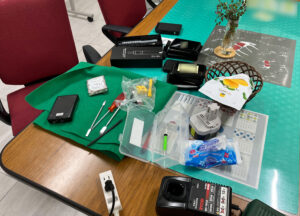*This service is for staff only.
Are you safely deleted your data while disposing of your old computer? Aren’t you relieved that you have deleted the data from the trash box? Or do you think it’s okay because you initialized it?
That’s dangerous!!
There is a risk that such data can be quickly rescued by data recovery software!!
Please be careful when disposing of or transferring your computer. Personal information and valuable research data may leak out, and the impact can be enormous!
Kyoto University is raising awareness about loss and theft prevention and disposal in “【Limited on-Campus】Preventing Information Leakage”
As part of our information security measures, our information processing room is helping our staff with data erasure. If you are a staff member, please consult with the Information Processing Room.
Disk encryption (recommended) and setting a PC login password (required)!
Even if you accidentally dispose of your data without erasing it, if the storage media is encrypted, the risk of third-party access to your data can be significantly reduced unless someone logs into the device. Kyoto University and our research institute have systematically introduced Google Drive, and our policy is not to store data on storage media. For Macs, you can easily encrypt your internal disk by enabling FileVault. For Windows, you will need to use BitLocker, but there may be cases where it does not work well depending on the device, so it is better for our staff to consult with the Information Processing Office.
Data erasure
In our Center, for hard disks, we attempt physical destruction using a dedicated machine (CrushBox HDB-20V by Nitto Seiki Co., Ltd.) that can compress and destroy the disk. If that is not possible, we attempt logical erasure based on the U.S. National Security Agency (NSA) method through the dedicated machine. We make it difficult to recover data at the electromagnetic level by writing to the entire area with three different writes as much as possible.
Moreover, we also attempt to physically destroy the HDD as shown in the figure below.
If this is not possible, we will attempt to physically destroy the HDD by disassembling it as shown above.
*If you have special equipment that does not allow you to do so or if it is difficult to do so, please ask the erasure company to erase the data depending on the importance of the stored data. There are also methods such as melting.
Types of data erasure
- Data erasure(Wikipedia)
Why is it possible to recover data even after it has been deleted?
In the case of a hard disk, as part of a technique to speed up processing, when data is deleted, a “deleted” mark is placed on the data area. If there is a “deleted” mark in that area when data is written in the future, the data is overwritten and saved. By doing this, the actual deletion process can be omitted, making it faster.
In this case, even if you accidentally delete it from the trash can, the actual data is still there, marked as “deleted.” Of course, you cannot view it using normal methods, but you can find it using dedicated software.
Formatting uses the same technique.
However, if you use the “Securely Empty Trash” feature that comes standard on Mac or perform a complete format, data recovery becomes difficult. This is because they delete data thoroughly. In reality, some dummy data is overwritten.
For USB memory and SD cards used in digital cameras, etc., there are cases where complete deletion is performed when data is deleted.
Furthermore, with advanced technology and equipment, it is sometimes possible to recover data that has been completely deleted at the electromagnetic level (residual magnetism).
It is difficult to completely prevent this, but you can lower the probability of recovery by increasing the level of erasure. However, increasing the erasure level takes several times longer.
What should you do if you want to do it yourself?
Use data erasure software or hardware to completely erase the data.
Hardware is relatively expensive, so it is not recommended for individual use. There are also free software options available, but please research and use one that seems suitable for you. Otherwise, a commercial product would be better.
Especially to erase an internal hard disk, it is impossible from the currently running OS (because the OS is running), so it is necessary to create a CD boot or USB boot and erase it, which is relatively difficult (once you do it, you will get used to it, but it is high hurdle).
Points to note when erasing on macOS
Created: April 19, 2021
In the case of recent macOS disks (SSDs), the security options are limited, and safer deletion methods such as three-time deletion cannot be used. Therefore, it is recommended to try using Terminal in the recovery mode.
- Start in recovery mode.
- Erase the disk once in Disk Utility.
- Start Terminal.
Check the disk drive information in /dev/by entering diskutil list command.
Enter the following command and it will be written randomly three times.
diskutil randomdisk 3 /dev/[disk name]
289th June, 2023 Created.

